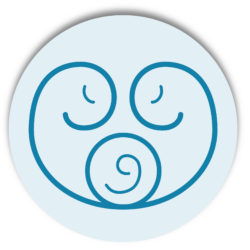Ovarian Cysts
Ovarian cysts at a glance
- Ovarian cysts are solid or fluid-filled sacs (cysts) within or on the surface of one or both ovaries.
- Women of any age can develop ovarian cysts.
- Most ovarian cysts are non-cancerous, usually disappear on their own and produce no symptoms.
- If an ovarian cyst does rupture it can cause serious symptoms such as severe abdominal or pelvic pain.
- Treatment options include observation, surgical removal and hormone therapy (birth control pills) to prevent the growth of additional cysts.
What are ovarian cysts?
Ovarian cysts are fluid-filled sacs that can form in the ovaries and are very common during the childbearing years (19-45). Ovarian cysts can develop for several reasons, described below, and are related to a woman’s reproductive system and ovulation.
Women have two ovaries located on either side of the uterus in which eggs are developed and mature during the course of a woman’s reproductive years. The ovaries produce hormones, including estrogen, which trigger the monthly menstruation cycle. Every month the woman ovulates, meaning one of the ovaries releases one small egg that makes its way down the fallopian tube to potentially be fertilized.
There are several types of ovarian cysts, including:
Functional
The most common type of cyst, functional cysts, also called follicular cysts, form during ovulation and happen when either the egg isn’t released or the sac in which the egg forms does not dissolve after the egg is released. They generally go away on their own without treatment.
Corpus luteum
Another common form of ovarian cyst occurs when a follicle ruptures after it has released an egg but does not re-seal. The cyst forms in the corpus luteum, a gland that produces progesterone and estrogen. Corpus luteum cysts can become large (more than 3 inches long) and can rupture, rotate and twist the ovary, causing pain symptoms.
Polycystic ovaries
When a woman fails to ovulate an egg, secondary to chronic changes in hormone levels disrupt normal egg development; the ovaries may appear larger and have an abundance of fluid-filled sacs or cysts. This condition is also known as polycystic ovary syndrome (PCOS).
Cystadenomas
These cysts form out of cells on the surface of the ovary. They are often fluid filled, can become very large causing symptoms, and are often removed by surgery.
Dermoid
Comprised of the same tissue as bone, fat, hair or cartilage, dermoid cysts may become inflamed and cause ovarian torsion or twisting.
Hemorrhagic
When a cyst forms in the ovary and is filled with blood.
Endometrioid
Endometrioid cysts develop when endometrial cells (cells normally found in the lining of a woman’s uterus) grow within the ovary. This condition affects women during their reproductive years, and is a common cause of chronic pelvic pain.
Causes of ovarian cysts
- Hormonal imbalance: Sometimes cysts can be caused by drugs used to help women ovulate. Functional cysts are the types of cysts usually caused by hormonal imbalance.
- Endometriosis: This is when tissue that normally grows inside the uterus grows on the outside and causes an ovarian cyst because the endometrial tissue attaches to the ovary and forms a growth.
- Pelvic infections: Cysts can form because of severe pelvic infections that spread to the ovaries and fallopian tubes.
- Pregnancy: Normally an ovarian cyst develops in early pregnancy to help support the pregnancy until the placenta forms. The cyst sometimes stays on the ovary until later in the pregnancy and may need to be removed.
Symptoms of ovarian cysts
Most cysts don’t cause any symptoms and go away on their own. If a cyst does cause symptoms, a woman may experience abdominal pressure, swelling, bloating or pain in the lower abdomen on the side of the cyst. The pain may be sharp or dull, and may be intermittent or constant. Women should seek medical attention if sudden, severe abdominal or pelvic pain occurs.
Sometimes women don’t realize they have an ovarian cyst until they visit their healthcare provider for a routine pelvic exam. Cystic ovarian masses that develop after menopause may be cancerous (malignant). That’s why it’s important to have regular pelvic exams with your medical provider.
Treatment of ovarian cysts
Treatment depends on the type of cyst, the size and symptoms experienced by the woman. In many cases doctors recommend watchful waiting. If a woman has no symptoms and an ultrasound shows a small, fluid-filled cyst, a doctor may recommend periodic follow-up exams every one to three months to see if there’s been any change in the size or appearance of the cyst. Birth control pills can also be used to reduce the chance of new cysts developing during subsequent menstrual cycles.
If a cyst is large, consistently growing and not a functional cyst, your doctor may suggest surgically removing it. Cysts that cause enough pain or other severe symptoms also may need to be removed.

